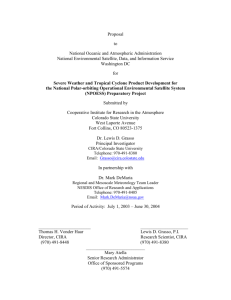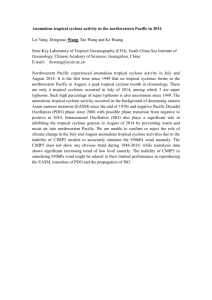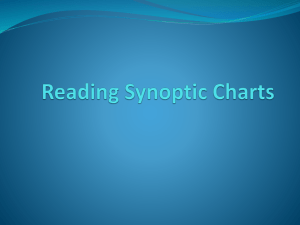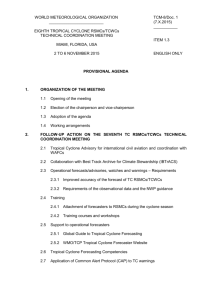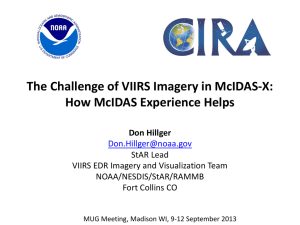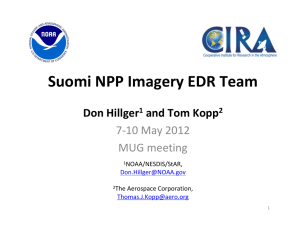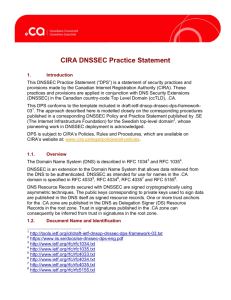Severe Weather and Tropical Cyclone Product Development for
advertisement
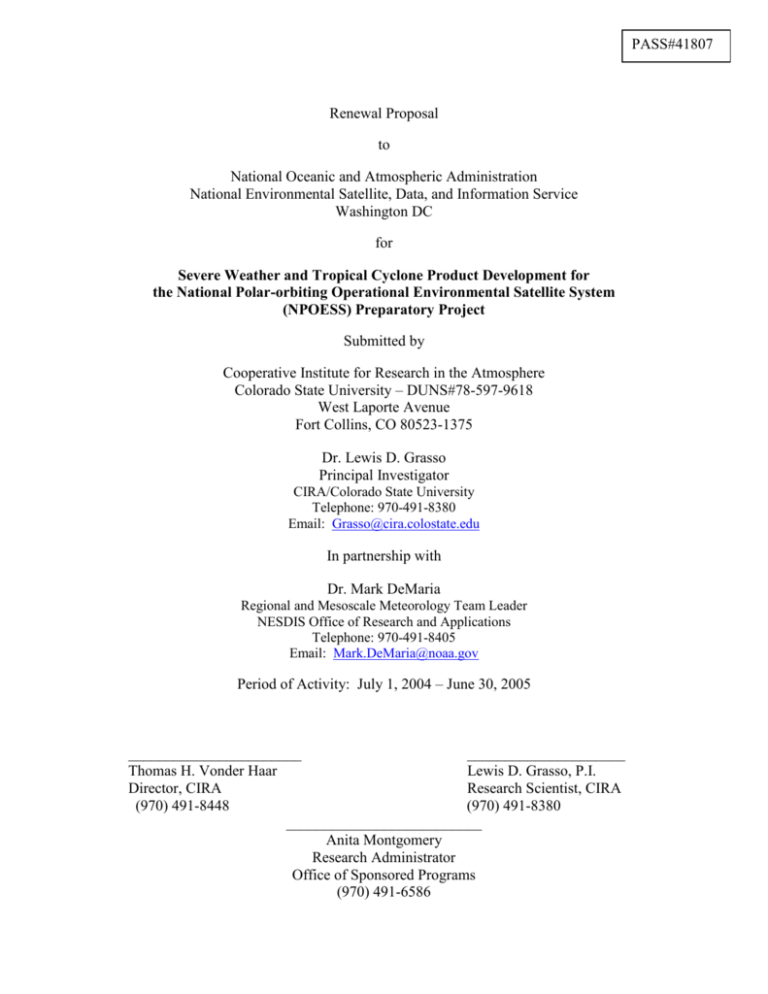
PASS#41807 Renewal Proposal to National Oceanic and Atmospheric Administration National Environmental Satellite, Data, and Information Service Washington DC for Severe Weather and Tropical Cyclone Product Development for the National Polar-orbiting Operational Environmental Satellite System (NPOESS) Preparatory Project Submitted by Cooperative Institute for Research in the Atmosphere Colorado State University – DUNS#78-597-9618 West Laporte Avenue Fort Collins, CO 80523-1375 Dr. Lewis D. Grasso Principal Investigator CIRA/Colorado State University Telephone: 970-491-8380 Email: Grasso@cira.colostate.edu In partnership with Dr. Mark DeMaria Regional and Mesoscale Meteorology Team Leader NESDIS Office of Research and Applications Telephone: 970-491-8405 Email: Mark.DeMaria@noaa.gov Period of Activity: July 1, 2004 – June 30, 2005 _______________________ _____________________ Thomas H. Vonder Haar Lewis D. Grasso, P.I. Director, CIRA Research Scientist, CIRA (970) 491-8448 (970) 491-8380 __________________________ Anita Montgomery Research Administrator Office of Sponsored Programs (970) 491-6586 1. Introduction The Advanced Microwave Sounder Unit (AMSU) on the National Oceanic and Atmospheric administration (NOAA) K, L, and M satellites was incorporated into operations in a relatively short period of time due to advance preparations. Based upon this success, preparation is needed before new sensors are launched; as a result, operational use of the instruments can be extended. In this second year proposal, we continue a program to use output from mesoscale and radiative transfer models to develop simulated Visible Infrared Imager Radiometer Suite (VIIRS) imagery that will be included as part of the NPOESS Preparatory Project (NPP). The model output will also be used to simulate temperature soundings that will be similar to those available from the Advanced Technology Microwave Sounder (ATMS) planned for the NPP. MODIS observations will also be used to simulate the VIIRS imagery. Simulated VIIRS imagery and ATMS soundings will be used to design new products for severe thunderstorms and tropical cyclones. Applications will include the following: precipitation estimation, tropical cyclone intensity and wind structure diagnosis, including an advanced Dvorak technique (Dvorak 1984), and severe weather signatures--such as the enhanced-V (McCann 1983). 2. Numerical Model Description The numerical model planned for this study is version 4.29 and 4.3 of the Regional Atmospheric Modeling System (RAMS) developed at Colorado State University (Pielke et al. 1992). The model includes the following features: Non-hydrostatic and compressible (Tripoli and Cotton 1982); Momentum is advanced using a leapfrog scheme; scalars are advanced using a forward scheme: Both methods used second order advection; Vertical and horizontal turbulence are parameterized using a Smagorinsky deformation based eddy viscosity (Smagorinsky 1963) with stability modifications (Lilly 1962); Hydrometeors are predicted with a new two-moment bulk microphysical scheme (Meyers et al. 1997). Hydrometeor mixing ratio and number concentrations are prognosed while the mean diameter is diagnosed. The following hydrometeor species are available: cloud droplets, rain droplets, aggregates, grauple, hail, snow, and pristine ice; Other prognostic variables are the three components of momentum--u, v, w; Exner function, π; total water, rt; and ice-liquid potential temperature, thetail (Tripoli and Cotton 1981); Arakawa fully staggered C grid (Arakawa and Lamb 1981); Exner function tendencies used to update the momentum variables are computed using a time split scheme, similar to Klemp and Wilhelmson (1978); 2 Lateral boundaries use the Klemp-Wilhelmson condition, in which the normal velocity component specified at the lateral boundary is effectively advected from the interior. 3. Radiative Transfer Modeling VIIRS will have a total of 22 channels (Welsch et al. 2001). Six of these channels (I1-6), which cover parts of the visible and infrared spectrum (0.645, 0.7, 0.865, 1.61, 3.74, and 11.45 μm), will be devoted to imagery. Other channels--designated M--will be used more quantitatively for a number of different applications: Visible/NIR - M1-5, M7: Ocean color and aerosols; NIR - M8: 1.24 μm, clouds; M9: 1.378 μm, clouds; M10: 1.61 μm, snow; M11: 2.25 μm, clouds; M12: 3.70 μm, SST, clouds; and M13: 4.05 μm, SST, fires, clouds; IR - M14: 8.55 μm, clouds; M15-16: Split window; and Spatial resolution for most channels will be 400 m x 400 m at nadir. Our main interest is the cloud information supplied by IR channels M8-16. Channels M14-16 measure emission and scattering of thermal radiation, while channels M8-13 include scattering of solar radiation as well as thermal emission. The radiative transfer models for computing radiances, the cloud single-scatter (or optical) models, and gas models contain the following features: M8-13: Spherical Harmonic Discrete Ordinate Method (SHDOM; Evans 1998); M14-16: Eddington 2-stream method (e.g, Deeter and Evans 1998); M8-16: Cloud optical model: Modified Anomalous Diffraction Theory (MADT; Mitchell 2000) applied to both liquid and ice particles; and M8-16: Gas extinction model: Optical Path TRANsmittance (OPTRAN; McMillin et al. 1995). SHDOM, a fast multi-stream model, and Eddington 2-stream model are currently part of CIRA's Regional Atmospheric Modeling and Data Assimilation System (RAMDAS; Vukicevic et al. 2001). MADT has been successfully applied to liquid and ice clouds (Grasso and Greenwald 2004; Greenwald et al. 2002; Vukicevic et al. 2001). Because of our interest in cloudy radiances, precise values of surface emissivity/albedo are not critical, thus, typical values are used. Surface temperature is derived from RAMS. 4. First Year (FY03) Results During the first year of the demonstration project, infrared brightness temperatures were simulated for an idealized thunderstorm simulation at the resolution of the VIIRS footprint. Because of the lack of filter function coefficients for VIIRS channels, brightness temperatures were produced through the use of GOES-9 coefficients. Brightness temperatures were then compared to simulated 3 rain rates from the model. Statistics are being generated to examine the feasibility of developing a rain rate retrieval algorithm. In addition, brightness temperatures are also being compared to updrafts speeds within the core of the thunderstorm. One consequence of the current computer capabilities was that an idealized simulation of a tropical cyclone was impractical. We are in the process of moving the RAMS model to a 64-bit machine. With the additional memory and speed, a tropical cyclone can be simulated at the VIIRS footprint resolution for a case initialized with real data. In particular, most of the tropical cyclone will be contained in the high-resolution part of the domain. Further, thunderstorm cases can also be simulated from real data. Also in the first year project members coordinated with representatives from the Joint Center for Satellite Data Assimilation (JCSDA) to obtain OPTRAN coefficients for the MODIS channels. These provide a much closer match to VIIRS than the GOES channels, so that the VIIRS imagery can be simulated more accurately. These will be implemented in the second year. 5. Second Year (FY04) Plans Plans are to simulate the severe weather event that occurred on 8 May 2003 over the central plains of the United States along with a tropical cyclone Lili that occurred in early October 2002 over the Gulf of Mexico and southern United States. The use of real data cases will allow us to simulate thunderstorms and tropical cyclones with properties that are more similar to those found in nature. Additional data from the severe weather case will allow us to continue building statistics between rain rates and brightness temperatures along with updraft speeds and brightness temperatures. Temperatures from the tropical cyclone simulation will be sub-sampled at the AMSU (50 km) footprint and ATMS (25 km) footprint resolutions. Sub-sampled temperature profiles will then be used to test the tropical cyclone wind retrieval algorithm developed by Demuth et al. (2004). In addition to numerical modeling activities, MODIS infrared imagery of tropical cyclones will be used to test the objective Dvorak technique (Dvorak 1984) similar to that from VIIRS. Results will be compared to the operational Dvorak technique from GOES data. Further, filter function coefficients from MODIS will be used from channels 9 (8.53 μm), 11 (11.02 μm), and 12 (12.03 microns) since these approximate the VIIRS infrared channels. The primary goals for the second year are as follows: 1. Complete the demonstration of the use of simulated imagery to develop a rain rate algorithm for thunderstorms. 2. Determine if the VIIRS imagery can provide a useful relationship between severe storm updraft speed and cloud-top structure. 3. Estimate the potential improvement of the ATMS over the AMSU for a tropical cyclone wind retrieval algorithm. 4. Use MODIS imagery to determine the potential benefit of the VIIRS imagery for the Dvorak tropical cyclone intensity estimation method. The last three of the above goals will set the stage for the development of experimental forecast products to be tested when real NPP data becomes available. 4 6. Future activities Future plans include the development of three algorithms that will be tested with the launch of NPP in 2006. First is the development of an algorithm that will retrieve vertical motion from brightness temperatures from the tops of thunderstorms; secondly, develop an algorithm to retrieve tropical cyclone winds from the ATMS temperature field. Currently, the algorithm is designed for AMSU data; lastly, develop an algorithm for the Dvorak technique from MODIS data, and then test it on VIIRS data when it becomes available. 7. Coordination with NOAA This work will be coordinated with other individuals within NOAA ORA, including Dr. Fuzhong Weng, Dr. Andrew Heidinger, and Dr. Thomas Kleespies. We already have experience working with Dr. Kleespies, who provided support for OPTRAN in developing RAMDAS, and have had limited collaboration with Dr. Heidinger in retrieving cloud properties at visible/NIR wavelengths. Dr. Weng would provide assistance with ATMS simulations. Forward radiative transfer models developed here could be incorporated into operational models, once their cloud physics parameterizations are improved. 8. Second year budget A detailed budget is provided in the Appendix. Further details on the Budget items are provided below. Budget Item I and II: PERSONNEL and FRINGE BENEFITS The project personnel include Mark DeMaria and Raymond Zehr from NESDIS, and Thomas H. Vonder Haar, Hiro Gosden, Manajit Sengupta, and Kathy Fryer from CIRA/CSU. The project will be directed by M. DeMaria and L. Grasso, with general oversight by the director of CIRA (T. Vonder Haar). No funds are requested for M. DeMaria, R. Zehr or T. Vonder Haar, since these will be covered by NESDIS and CIRA base funding, respectively. It is anticipated that M. DeMaria will contribute one month for project oversight and R. Zehr will contribute 2 months for the development of the VIIRS Dvorak algorithm. Funds are also included for 4 months for L. Grasso for mesoscale modeling and severe weather analysis, M. Sengupta (3 months) for radiative modeling, 1.25 months for H. Gosden for computer support, and 1.5 months for K. Fryer for administrative support. Base salaries included in this proposal reflect the actual salaries approved by the Governing Board of Colorado State University for the period July 1, 2004 through June 30, 2005. Fringe Benefits: The following federally approved CSU rates were applied to the FY 2004-05 salaries based on the individual’s payroll classification: Faculty/Administrative Professional 20.1%, State Classified 18.2%. Budget Item 3: DOMESTIC TRAVEL Travel is budgeted for one trip to Norfolk, VA to present results from this work at the AMS conference on satellite meteorology and oceanography. 5 Budget Item 4: OTHER The CIRA Infrastructure charge provides computer and data support associated with this project. The NT hourly rate is determined by CIRA and depends on the actual cost of the CIRA computer operations. CIRA charges Windows NT computer costs on an hourly basis, based on log-on time collected electronically via infrastructure programs. Publication charges have also been added for the dissemination of research results. Budget Item 4: INDIRECT COST RATE The Indirect Rate of 20% is charged on this proposal. The rate is applied to Modified Total Direct Costs (MTDC). MTDC is defined as Total Direct Costs less Equipment, GRA Tuition, and Subcontracts > $25,000. 9. References Arakawa, A., and V. Lamb, 1981: A potential enstrophy and energy conserving scheme for the shallow water equations. Mon. Wea. Rev., 109, 18-36. Deeter, and K. F. Evans, 1998: A hybrid Eddington-single scattering radiative transfer model for computing radiances from thermally emitting atmospheres. J. Quant. Spect. Rad. Transfer, 60, 635-648. Demuth, Julie L., DeMaria, Mark, Knaff, John A., Vonder Haar, Thomas H. 2004: Evaluation of Advanced Microwave Sounding Unit tropical cyclone intensity and size estimation algorithms. Journal of Applied Meteorology, 43, 282-296. Dvorak, V. F., 1984: Tropical cyclone intensity analysis using satellite data. NOAA Tech. Rep. NESDIS 11, National Oceanic and Atmospheric Administration, Washington, DC, 47 pp. [Available from National Technical Information Service, U.S. Dept. of Commerce, Sills Bldg., 5285 Port Royal Road, Springfield, VA 22161.] Evans, K. F., 1998: The spherical harmonics discrete ordinate method for three-dimensional atmospheric radiative transfer. J. Atmos. Sci., 55, 429-446. Grasso, Lewis D., Greenwald, Thomas J. 2004: Analysis of 10.7-μm Brightness Temperatures of a Simulated Thunderstorm with Two-Moment Microphysics. Monthly Weather Review, 132, 815– 825. Greenwald, Thomas J., Hertenstein, Rolf, Vukicevic, Tomislava. 2002: An All-Weather Observational Operator for Radiance Data Assimilation with Mesoscale Forecast Models. Monthly Weather Review, 130, 1882–1897. Klemp, J.B. and R.B. Wilhelmson, 1978: The simulation of three-dimensional convective storm dynamics. J. Atmos. Sci., 35, 1070-1096. Lilly, D. K., 1962: On the numerical simulation of buoyant convection. Tellus, 14, 148-172. 6 McCann, D.W., 1983: The enhanced-V, a satellite observable severe storm signature. Mon. Wea. Rev., 111, 887-894. McMillin, L. M., L. J. Crone, M. D. Goldberg, and T. J. Kleespies, 1995: Atmospheric transmittance of an absorbing gas, 4. OPTRAN: A computationally fast and accurate transmittance model for absorbing gases with fixed and variable mixing ratios at variable viewing angles. Appl. Opt., 34, 6269-6274. Meyers, M. P., R. L. Walko, J. Y. Harrington, and W. R. Cotton, 1997: New RAMS cloud microphysics parameterization. Part II: The two-moment scheme. J. Atmos. Res., 45, 3-39. Mitchell, D. L., 2000: Parameterization of the Mie extinction and absorption coefficients for water clouds. J. Atmos. Sci., 57, 1311-1326. Pielke, R.A., W.R. Cotton, R.L. Walko, C.J. Tremback, W.A. Lyons, L.D. Grasso, M.E. Nicholls, M.D. Moran, D.A. Wesley, T.J. Lee, J.H. Copeland, 1992: A comprehensive meteorological modeling system-RAMS. Meteor. and Atmos. Phys., 49, 69-91. Smagorinsky, J., 1963: General circulation experiments with the primitive equations. Part 1: The basic experiment. Mon. Wea. Rev., 91, 99-164. Tripoli, G.J., and W.R. Cotton, 1982: The Colorado State University three dimensional cloud mesoscale model,1982. Part I: General theoretical framework and sensitivity experiments. J. Rech. Atmos., 16, 185-220. Tripoli, G.J., and W.R. Cotton, 1981: The use of ice-liquid water potential temperature as a thermodynamic variable in deep atmospheric models. Mon. Wea. Rev., 109, 1094-1102. Welsch et al., 2001: VIIRS (Visible Infrared Imager Radiometer Suite): A next-generation operational environmental sensor for NPOESS, International Geosc. and Remote Sensing Symp. (IGARSS) Proc., July 8-14. Vukicevic, T., T. Greenwald, R. Hertenstein, and M. Ghemires, 2001: Use of cloudy radiance observations in mesoscale data assimilation. 5th Symp. Integ. Obs. Systems, Albuquerque, New Mexico. 7



